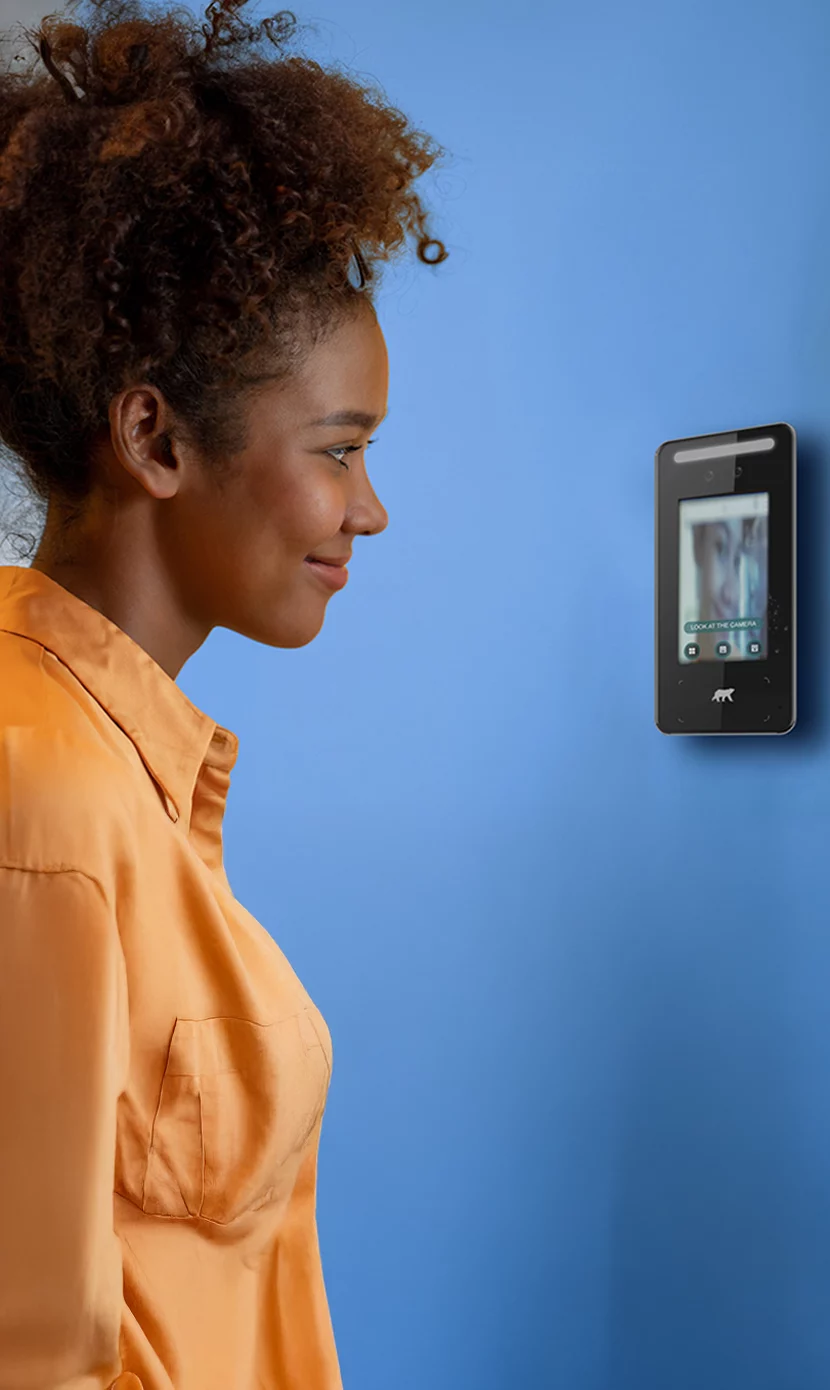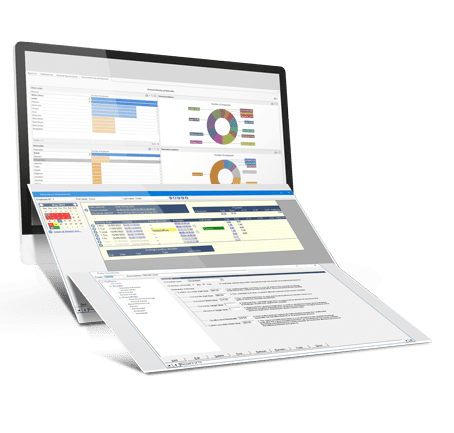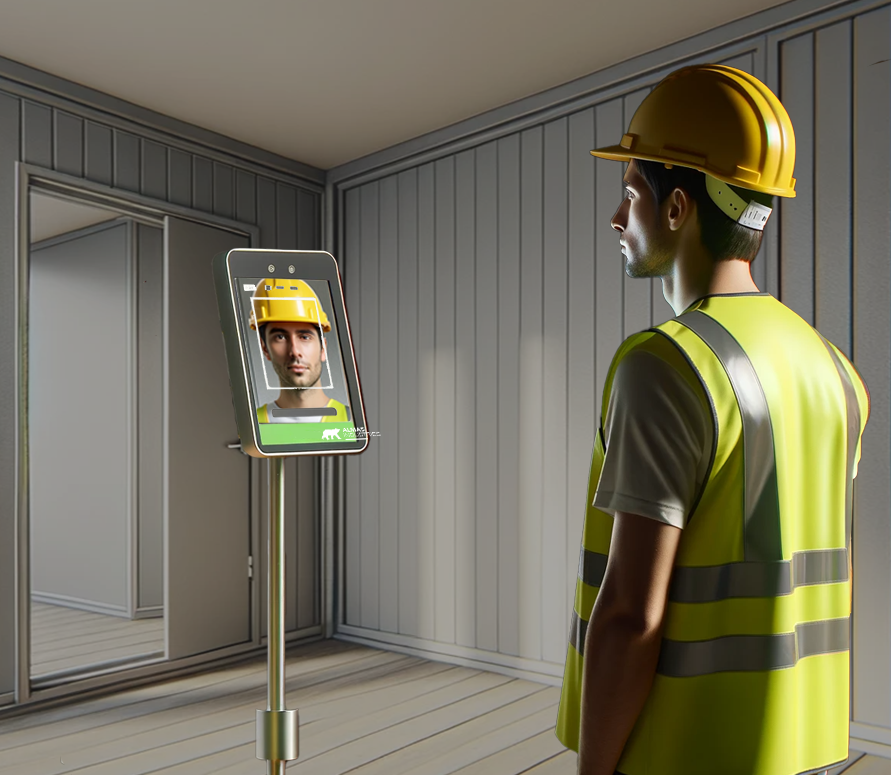
Safe Spaces, Happy Faces: How Employers Benefit When They Prioritise Workplace Security
for UK and Irish Employers
Are you looking for the best clocking in machine for your business? Modern time and attendance systems have revolutionised the way businesses monitor employees’ working hours. These devices, which come in many shapes, sizes and types, from fingerprint clocking in machines to mobile time and attendance apps, streamline the process of time tracking, rotas and pay for staff. Reporting delivers valuable insights for improving productivity, managing risk and identifying efficiency gains in your HR resources.
To help you decide which will be the best time tracking system for your business we’ve put together the definitive guide to clocking in machines; from cost and factors to consider, to GDPR considerations and we also debunk some terminology.
A time and attendance system usually cost consists of hardware and software, onboarding fee and support costs. Our solutions are fully inclusive - so one monthly fee includes everything - no hidden extras.
Clocking in systems collect personal data. It's vital that you collect and keep this in line with GDPR to remain compliant with record keeping requirements and a privacy first approach. We address employer responsibilities and employee concerns around clocking in.
What are employer's responsibilities around GDPR when it comes to clocking in?
What rights do employees have with regards to time tracking?
We outline which employment laws have an impact for time and attendance monitoring, and address employer and employee concerns around the use of time and attendance data.
Which laws are relevant to clocking in systems?
Can time tracking records be used for HR disciplinary purposes?
Can an employee refuse to use a biometric clocking in system?
It’s a time and attendance system that meets your business’ operational needs, is scalable as you grow, and that achieves the efficiencies you hope to gain.
However, there is a dizzying array of clocking in devices, time tracking softwares and support packages on the market. How do you choose which one is the right one for you? Unfortunately, the answer is that it’s not a simple answer.
The clocking in system that’s right for an SME with 50 employees won’t meet all the needs or statutory requirements for a PLC with 10,000 employees. The process to implement will take time, and should be planned and well supported by your chosen supplier.
Implementation Success Starts with Scoping
Launching a time tracking system in a business involves several crucial stages. We believe in working with our customers to find the best solution once we know their requirements – so get in touch and we will support you every step of the project! Just researching for now? Follow these and ensure a smooth transition and effective adoption – 8 Steps To Select The Best Clocking In Machine For Your Business.

We’re specialists in supporting smaller businesses implement new staff time tracking systems – from onboarding, installation, to ongoing training and technical support we’ll help you every step of the way – find tailored advice in our leading guide, or get in touch.

Traditional punch card machines have been a staple in workforce management for decades. Employees use physical cards. To clock in or out, they insert this card into the mechanical machine, which then stamps the time and date on it. The employee is given a paper time card for the pay period, which they insert into the time clock. The clock then punches or stamps the time and date onto the card, providing a record of when the employee clocked in or out. At the end of the pay period, the employer or HR department gathers all the cards and manually calculates the hours worked by each employee. If you’re still using these.. it’s time for an update.
Pros:
![]() Cost-effective
Cost-effective
![]() No need for technical expertise
No need for technical expertise
Cons:
![]() Requires manual data entry
Requires manual data entry
![]() Limited features
Limited features
![]() Prone to time theft and buddy punching
Prone to time theft and buddy punching
RFID (Radio Frequency Identification) card/ fob machines represent progression over traditional punch cards. Employees use electronic cards that are scanned by the machine to record their attendance. This system reduces the chances of buddy punching but doesn’t eliminate the risk as a card can be given to a colleague. NFC points log attendance when tapped by the employee’s mobile phone – the clocking in is all through the app. It’s a lower cost alternative to other timeclocks.
Pros:
![]() Reduces manual errors
Reduces manual errors
![]() Reduces time theft
Reduces time theft
![]() Easy integration or import into payroll and HR systems
Easy integration or import into payroll and HR systems
Cons:
![]() Cards can be lost or damaged
Cards can be lost or damaged
![]() Dependent on electronic systems which can fail
Dependent on electronic systems which can fail
![]() Rely on the employee having a phone
Rely on the employee having a phone
Biometric clocking in machines utilise unique biological characteristics such as fingerprint clocking in, facial recognition, or iris scans to verify an employee’s identity against an already enrolled template. This technology ensures the highest level of accuracy and security, eliminating the possibility of buddy punching and time fraud.
Pros:
![]() Highly accurate and secure
Highly accurate and secure
![]() Eliminates buddy punching
Eliminates buddy punching
![]() Streamlines payroll processes and saves time
Streamlines payroll processes and saves time
Cons:
![]() Higher initial cost
Higher initial cost
![]() Privacy concerns
Privacy concerns
![]() Requires maintenance and regular updates
Requires maintenance and regular updates
With the rise of hybrid and flexible working arrangements, mobile clocking in apps have become increasingly popular. These apps allow employees to clock in and out using their smartphones, providing GPS tracking to verify their location. Most systems will integrate with on site clocking in systems too. Apps are ideal for businesses with remote workers, field employees, or those requiring flexible working hours.
Pros:
![]() Ideal for remote and flexible working
Ideal for remote and flexible working
![]() GPS tracking ensures location verification
GPS tracking ensures location verification
![]() Accessible and convenient for employees
Accessible and convenient for employees
Cons:
![]() Dependent on mobile device availability and battery life
Dependent on mobile device availability and battery life
![]() Potential privacy concerns regarding location tracking
Potential privacy concerns regarding location tracking
![]() Requires robust data security measures
Requires robust data security measures


Effective clocking in and out, also known as time tracking, plays a crucial role in business productivity.
As with any new system, there are pros and cons, that you should be aware of as you embark on your project.
![]() Payroll Accuracy:
Payroll Accuracy:
Clocking in and out ensures that employees are paid accurately for the time they have worked. This is especially important for hourly employees or those who work overtime. Accurate time records can prevent both underpayment and overpayment.
![]() Time Savings:
Time Savings:
Many modern clocking in systems can be integrated with payroll systems, streamlining the process of calculating pay based on hours worked. This saves hours of administrative time and reduces errors.
![]() Fairness:
Fairness:
Time tracking ensures that employees are rewarded fairly based on their work. It can prevent disputes over hours worked and can contribute to a sense of fairness and transparency in the workplace. Buddy punching and time theft is quickly identified. Objective data on employees’ attendance and punctuality encourages a fair work culture where all employees are treated equally based on their actual working hours.
![]() Legal Compliance:
Legal Compliance:
Employment laws in the UK and Ireland regulate matters such as hours worked, overtime and mandatory breaks. Accurate time tracking helps ensure compliance with these laws and provides evidence in case of a dispute or a tribunal. Paper records are easily lost after a period of time, while tribunals can take place years after a dispute.
![]() Efficient Record Keeping:
Efficient Record Keeping:
Electronic time and attendance systems digitalise records, making it easier to manage, access, and review employee data. This can be extremely helpful for HR departments during audits or performance reviews.
![]() Prevention of Time Theft:
Prevention of Time Theft:
Time theft, where employees are paid for time they have not actually worked, can be a significant expense for businesses. It comes in many forms, you can read around this in more detail.
![]() Improved Productivity:
Improved Productivity:
Time tracking can provide valuable data about employee productivity. With a biometric system, the process of clocking in and out is quick, and data is automatically recorded and processed. This frees up time that might have been spent on manual data entry or error correction, allowing more time for productive work. It can identify tasks that require more resources than others, and can keep track of annual leave and absences. This can help managers make informed decisions about workflow and resource allocation.
![]() Cost Management:
Cost Management:
By accurately tracking employee hours, businesses can better understand employment costs and manage them more effectively. This helps with budgeting, forecasting, and overall financial management.
![]() Project Management:
Project Management:
In companies where time tracking is done at the task or project level, these records can be useful in future project planning. Understanding how long certain tasks take can assist in setting realistic project timelines and expectations and better customer satisfaction.
![]() Billing Clients:
Billing Clients:
For businesses that bill clients based on consultancy hours and time spent, this is relevant for many sectors including cleaning agencies, care sector, security staff, financial services and many more. Accurate time tracking is essential to ensure clients are billed correctly.
While the method used for clocking in and out can vary, the underlying principle of accurately recording work hours remains essential across various industries and businesses.
 Scalability:
Scalability:Consider the growth potential of your business. Will the chosen clocking machine be able to handle an increasing number of employees? Make sure the system can accommodate your future needs without requiring a complete overhaul.
If you already use HR or payroll software, check if the clocking machine can integrate with those systems. Seamless integration can streamline your administrative processes and eliminate manual data entry.
Look for a clocking machine that offers robust reporting and analytics features. This will allow you to generate attendance reports, track employee hours, and analyse data to make informed decisions about scheduling, overtime, and labor costs.
Depending on your industry and location, there may be specific labour regulations and compliance requirements that you need to adhere to. Ensure that the time and attendance system can support these compliance needs, such as tracking breaks, managing overtime, and generating legally required reports. You’ll also need to consider GDPR / UK GDPR implications of changing your time tracking method.
Consider the user-friendliness of the clocking machine. A straightforward interface and intuitive navigation will make it easier for employees to clock in and out accurately, reducing errors and frustration.
Check the level of support provided by the vendor. Look for reliable customer support channels, such as phone or email, and inquire about software updates and maintenance requirements. A responsive support team can help address any issues promptly.
Determine your budget for a time and attendance system, including both upfront costs and ongoing expenses such as licensing fees or maintenance. Consider the return on investment (ROI) the system can provide in terms of time saved, reduced errors, and improved efficiency.
Ensure that the clocking machine has appropriate security measures to protect employee data. Features such as encryption, secure data storage, user consent and user access controls are essential to maintain data privacy compliance.
Implementing a new time tracking system requires planning and great communication to get buy in from all users. Being clear throughout will not only help you with compliance but will mean you get the most out of your new clocking in system. Awareness of the following ‘disadvantages’ will help you combat and craft messaging that reassures your users.
![]() Privacy Concerns: Employees may feel their privacy is being violated, especially with biometric or GPS-based systems. Employees may not agree with their biometric data being stored or think their location is being tracked.
Privacy Concerns: Employees may feel their privacy is being violated, especially with biometric or GPS-based systems. Employees may not agree with their biometric data being stored or think their location is being tracked.
![]() Cultural Impact: The use of time tracking systems can sometimes create a culture of distrust if employees feel they are being constantly monitored. This could negatively impact morale, productivity, and employee engagement.
Cultural Impact: The use of time tracking systems can sometimes create a culture of distrust if employees feel they are being constantly monitored. This could negatively impact morale, productivity, and employee engagement.
![]() Accuracy Issues: Not all time tracking systems are completely accurate. For instance, they might record a late arrival even if the employee was on the premises but just couldn’t clock in on time. Similarly, time spent at the desk does not necessarily equate to productivity.
Accuracy Issues: Not all time tracking systems are completely accurate. For instance, they might record a late arrival even if the employee was on the premises but just couldn’t clock in on time. Similarly, time spent at the desk does not necessarily equate to productivity.
![]() Technical Issues: Technology is not foolproof. Biometric scanners might not always accurately read information, or other types of time clocks might malfunction. Internet or power outages can also interfere with digital systems. All of these issues can lead to inaccuracies in time records. These can be corrected retrospectively in the records with a full audit trail.
Technical Issues: Technology is not foolproof. Biometric scanners might not always accurately read information, or other types of time clocks might malfunction. Internet or power outages can also interfere with digital systems. All of these issues can lead to inaccuracies in time records. These can be corrected retrospectively in the records with a full audit trail.
![]() Data Security: With digital and biometric systems, there is a risk of data breaches. It’s crucial for businesses to ensure they, and their supplier, have robust security measures in place to protect this data.
Data Security: With digital and biometric systems, there is a risk of data breaches. It’s crucial for businesses to ensure they, and their supplier, have robust security measures in place to protect this data.
![]() Legal Considerations: Different regions have different laws around time tracking and what kind of data employers can collect and store. Non-compliance with these laws can lead to legal issues and penalties. Read more about this in our Clocking In Legislation info blog.
Legal Considerations: Different regions have different laws around time tracking and what kind of data employers can collect and store. Non-compliance with these laws can lead to legal issues and penalties. Read more about this in our Clocking In Legislation info blog.
![]() Resistance to Change: As with any new system, there can be resistance from employees who are used to a certain way of doing things. Training and change management efforts will be needed to help employees adjust to the new system.
Resistance to Change: As with any new system, there can be resistance from employees who are used to a certain way of doing things. Training and change management efforts will be needed to help employees adjust to the new system.

In the UK and Ireland, the cost of clocking in machines can vary widely based on factors such as the type of machine and its features. Here are some approximate price ranges for clocking in machines in the UK. These estimates don’t take into account installation and the software to derive reports from the captured data.

These machines typically cost between £100 and £500, depending on the brand, quality, and additional features.
The cost for fingerprint scanners in the UK can range from £200 to £1,000, depending on factors such as brand, quality, capacity, and features. The most established of the biometric technologies widely in use for over 20 years make these a reliable and secure choice.
Facial recognition systems generally have a wider price range, starting from around £300 and going up to £1,500 or more, depending on the brand, security, quality, capacity, and features. It’s worth checking the number of cameras and data encryption technologies used on these devices. More cameras means a better qualify biometric template and therefore higher level of security. Data security and adherence to GDPR is vital if you’re considering facial time and attendance, you can read more on the privacy implications here.
The cost of apps is linked to the time and attendance software. It varies based on factors such as the supplier, the features, and the number of employees. Many software models work on a monthly subscription basis in bands of employees.
The cost of time and attendance software will vary based on several factors.
Investing time at the beginning to map out your requirements will result in a solution that is a better fit and that adds value to your business. Your scoping document should be formulated with input from all key stakeholders. The best suppliers will help you conduct this process thoroughly – it’s in their interests too! Better scoping now will mean fewer adjustments later which will set up a smoother onboarding process.
Basic Plans: Basic time and attendance software plans for small businesses with fewer employees typically start around £20 to £50 per month. These plans usually offer essential features such as clocking in/out, timesheet management, and basic reporting.
Mid-Range Plans: Mid-range plans with additional features and capabilities may range from £50 to £200 per month. These plans may include features like scheduling, leave management, overtime calculations, integration with payroll systems, and more extensive reporting options. These could be priced on a per user licence model.
Enterprise Plans: For larger organisations with complex workforce management needs, enterprise-level time and attendance software plans can range from several hundred pounds per month to several thousand pounds per month. These plans often offer advanced features, customisation options, integration with HR and payroll systems, and dedicated support.

It’s important to note that these pricing ranges are approximate and can vary significantly depending on the specific software provider, the number of employees you have, and any additional requirements or customisations. Some providers may also offer pricing based on annual contracts or charge additional fees for setup, training, or support.
To get accurate and up-to-date pricing information, please get in touch so we can provide you with specific details based on your business needs and employee numbers.

What are Clocking In Machines?

Fast forward to today and clocking in machines have evolved significantly! Punch clocks have been replaced by cards, mobile clocking in apps and more recently biometric systems backed by sophisticated software that helps run your workforce management operations.
Key Features include:
How does a clocking in machine work?
Well in very simple terms, there are 3 key steps:
However, of course modern time tracking systems have much more functionality because of the analysis of that data. Additional features include:
What Is Buddy Punching and how does it relate to Clocking In?
‘Buddy punching’ refers to a fraudulent practice where an employee clocks in or out on behalf of another employee. It commonly occurs in workplaces that use a time and attendance system or punch clock to record employees’ working hours.
Typically, an employee will ask a coworker to clock in or out for them when they are not actually present at work, or when they are running late, allowing them to falsely inflate their attendance records and potentially receive payment for hours they did not work.
Buddy punching can be a serious issue for employers as it leads to inaccurate timekeeping records and payroll discrepancies. It can result in financial losses for the company and may also create a negative work culture by undermining fairness and trust among colleagues.
How Do I Stop Buddy Punching In My Business?
To combat buddy punching, many organisations implement measures such as biometric time clocks (e.g., fingerprint or facial recognition) or unique access codes to ensure that only the intended employee can clock in or out (although that doesn’t stop an employee giving their code to a colleague). These systems help to verify the identity of the individual and reduce the likelihood of fraudulent timekeeping practices.
Overall, buddy punching is an unethical and dishonest behaviour that undermines the integrity of attendance tracking systems and can have detrimental effects on the employer, the team spirit and the workplace environment.
What is Time Theft?
At the same time clocking in machines were invented, employees started thinking of ways of circumvent them too! Time theft is when employees are paid for time they didn’t actually work or for tasks they didn’t actually perform. It’s essentially “stealing” time from an employer and can take many forms, including:
Buddy Punching: This is when one employee clocks in or out for another. For example, if an employee is running late, they might ask a coworker to clock in for them so it appears they arrived on time.
Long Breaks: Taking longer breaks than allocated, such as extended lunch hours or extra personal time, without making up for it.
Excessive Personal Time: Spending an excessive amount of work time on personal activities, such as making personal phone calls, browsing the internet, or socialising with coworkers, also constitutes time theft.
Late Arrivals or Early Departures: Frequently arriving late or leaving early without adjusting time records accordingly.
Inaccurate Timekeeping: Manually recording inaccurate start or finish times. For example, an employee might record that they started work at 8:00 AM when they actually arrived at 8:15 AM.
Time theft can have significant financial implications for a business, as it results in paying for work not actually performed. Some studies have estimated it as high at 7% of a company’s profits. Over time, even minor time theft can add up to substantial costs. This is why many businesses invest in time and attendance systems, which can help prevent many forms of time theft. However, it’s also important for businesses to foster a positive work culture where employees feel valued and are intrinsically motivated to do their best. This can also help mitigate the issue of time theft.
Check out our Time Theft Calculator to see how much it’s costing your business. You’ll be shocked!
Why is Time Theft Detrimental To Businesses?
Time theft can create a significant drain on resources, and its effects can be more widespread than just the financial impact. It’s important to understand the different ways in which time theft can harm an organisation:
Decreased Productivity: When employees engage in time theft, they’re not completing their tasks efficiently or to the best of their abilities. This leads to decreased productivity, which can impact a company’s bottom line and also delay project timelines.
Increased Operational Costs: Time theft results in higher payroll costs without any corresponding increase in productivity. This means the company is essentially paying for time that has not contributed to its operations or goals.
Poor Employee Morale: If certain employees are engaging in time theft and getting away with it, it can breed resentment among those who are following the rules. This can lead to a toxic work environment, which can further impact productivity and increase turnover.
Unfair Workloads: Time theft can result in an uneven distribution of work. Employees who are honestly putting in their hours may end up picking up the slack for those who are stealing time, leading to burnout and resentment.
Damages Reputation: If time theft becomes rampant and widely known, it could damage the company’s reputation, making it more difficult to attract quality talent or retain clients and customers.
Combating time theft requires a multi-pronged approach. Technological solutions like biometric time clocks or digital time-tracking software can certainly help. But it’s also important to foster a positive and transparent work culture where employees are aware of the consequences of time theft and feel motivated to contribute their best during their working hours.
Providing adequate breaks and ensuring workloads are reasonable can also reduce the temptation for employees to engage in time theft. Regular training, clear communication about company policies, and consistent enforcement can also go a long way toward minimising this issue.
How has time tracking evolved from its beginnings to the 21st Century
Did you know that timesheets have been around for over 4,000 years? But how has time tracking evolved and what’s the next natural evolution? Read about the evolution of time and attendance tracking…
.






